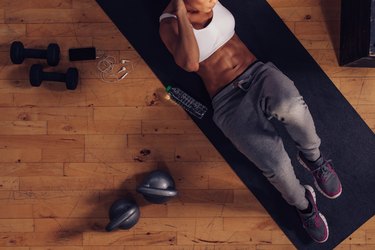
When participating in any exercise program, you will experience a fair amount of soreness, especially when you are first starting out. The important part is to know the difference between normal muscle soreness and pain from an injury. Often muscle soreness can escalate into injury when it is not cared for in the proper way, and it's important to listen to your body and know when to take appropriate action like rest or even seeing a doctor.
Tip
Your ribs may hurt after an ab workout from simple muscle soreness or from the lever action of the abdominal muscles pulling on the ribs at the point of attachment. This should dissipate in a few days. If you experience rib pain that worsens with exercise or doesn't improve after a few days, consult your doctor as it may be a sign of an injury or a more serious condition.
Video of the Day
Recognize Normal Muscle Soreness
It can often be difficult to pinpoint the origin of muscle soreness. Sore ribs that present with insidious onset, no discernible mechanism of injury, diffuse muscular discomfort and a general feeling of pleasure and relief with gentle stretching are generally indicative of delayed-onset muscle soreness, or DOMS.
Video of the Day
This is normal and should be treated with ice, stretching, rest and modified activity. The best way to get rid of DOMS is to continue moving and use physical activity to flush the muscles out. If you experience sharp, focal rib pain after an ab workout that increases with stretching and activity and does not resolve after several days of rest, you should seek medical consultation, as this can indicate a more serious injury.
Rib Pain After Ab Workout
If you experience soreness in your ribs after physical activity, it may be the result of abdominal muscle exertion that extends to the muscles over the ribs.
The rectus abdominus, oblique and transverse abdominus muscles, all the major muscles of the anterior abdominal area, attach to the ribs and costal cartilage surrounding the ribs. When you perform strenuous core exercises, the muscles pull on their attachment sites, using them as levers, and become engorged with blood and acidic byproduct.
As a result, they pull on their attachment sites after your exercises have ended. This can cause residual bone soreness on the ribs after activity that focuses on core strength, such as situps, and should subside after a few days at the most.
Preventing Sore Ribs
There are a couple of precautions you can take to prevent future soreness. Light physical activity is the best way to warm up muscles and prepare them for exertion. After a warmup of several minutes, stretch every major muscle that will be used for 30 to 60 seconds each. This helps protect them from damage and enhance flexibility, thus preventing future injuries and increasing your range of motion.
Stretching after your workout is as imperative to your physical fitness as pre-workout stretching and should be performed for an equal amount of time. To learn how to stretch accurately and thoroughly, enlist the help of an athletic trainer, physical therapist or yoga professional who can help you tailor your stretching program to your personal needs.
Consider adding yoga or another stretching activity to your fitness regime for an overall increase in total body flexibility as well as increases in endurance, balance and strength training for smaller, often forgotten, muscles that assist in stabilization and posture.
Read more: Intercostal Muscle Stretches
When to Stop Exercising
Listening to your body is a very important factor for anyone leading an active lifestyle. Paying attention to the signals it's sending you can mean the difference between a strong and productive workout and a disabling injury.
Take notice of the frequency of your pain, when you feel it, the type of pain — burning, stinging, dull ache, sharp, shooting and so on — and what makes your discomfort worse or better. This will help you to get a better idea of your ailment and will be helpful should you need to seek medical attention.